The global fish meal alternative market is valued at USD 2.2 billion in 2025 and is slated to reach USD 4.4 billion by 2035, reflecting a CAGR of 7.1%. Growth will be driven by the rising demand for sustainable animal nutrition, environmental concerns over traditional fishmeal production, and the expansion of aquaculture and poultry industries.
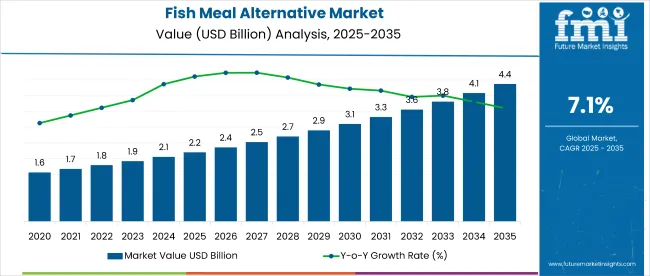
| Attribute | Value |
|---|---|
| 2025 Market Size | USD 2.2 billion |
| 2035 Market Size | USD 4.4 billion |
| CAGR (2025 to 2035) | 7.1% |
Plant-based protein sources, especially soy and algae-based ingredients, are being increasingly adopted for their digestibility and high nutritional value. Additionally, innovations in microbial and insect-based alternatives are gaining traction due to their lower environmental impact.
The USA is projected to record the fastest CAGR of 8.2% among countries. Germany follows with a CAGR of 7.6%, supported by eco-friendly livestock feed adoption, while France registers 7.3% due to sustainability policies. Among application segments, feed will dominate with a substantial 72% market share, largely attributed to high adoption rates in the poultry and aquaculture sectors. Based on type, the conventional segment will remain the top choice, capturing 65% of the market due to its cost-effectiveness and widespread availability.
Government regulations are playing a vital role in advancing the fish meal alternative market by promoting sustainable feed practices. In regions like North America and Europe, stricter policies are being implemented to reduce reliance on traditional fishmeal and combat overfishing. Authorities are supporting the use of plant-based, insect-based, and microbial proteins through subsidies, research funding, and eco-label incentives. Updated standards for aquaculture and livestock feed are also mandating the inclusion of alternative proteins. These regulatory efforts are expected to drive widespread adoption of sustainable and environmentally friendly feed solutions.
The fish meal alternative market holds a niche yet growing share across its parent markets. Within the animal feed market, it accounts for approximately 3%, reflecting its early but rising adoption. In the aquafeed market, its presence is more significant at around 8%, driven by increasing sustainability demands in aquaculture. It contributes about 5% to the alternative protein market, as it includes plant, insect, and microbial sources. In livestock nutrition and pet food ingredients, the share is estimated at 2-4%, with growing interest in cleaner, eco-friendly inputs accelerating future expansion within these broader segments.
The global market is segmented by type, source, application, and region. By type, the market includes organic and conventional. Based on source, the market covers plant-based sources such as peas, lupins, corn, rice, canola, rapeseed, barley, and wheat, along with animal-based and micro-organism-based alternatives.
In terms of application, the market includes feed (poultry, livestock, pet food, and treats), fertilizers, pharmaceuticals, and dietary uses. Regionally, the market is classified into North America, Latin America, Western Europe, Eastern Europe, South Asia and Pacific, East Asia, and the Middle East & Africa.
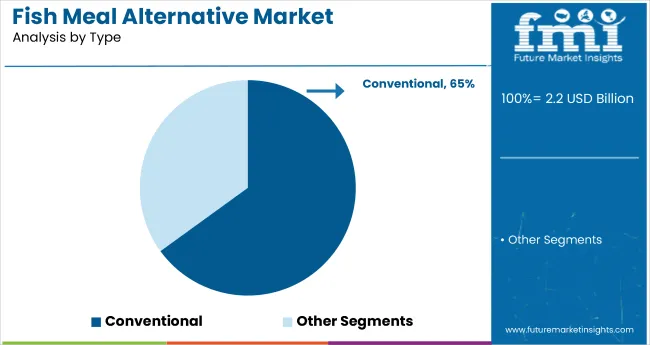
The conventional segment is expected to emerge as the most lucrative type in the fish meal alternative market, accounting for a market share of 65%. This dominance can be attributed to its cost-effectiveness, easier availability, and widespread acceptance among feed manufacturers across the aquaculture and livestock industries.
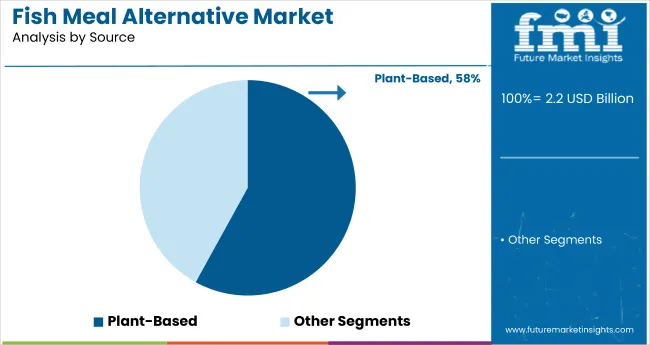
The plant-based source segment is projected to lead the fish meal alternative market, capturing a dominant 58% market share. This segment’s growth is driven by the high availability, nutritional profile, and cost efficiency of plant-derived proteins such as peas, lupins, corn, rice, canola, rapeseed, barley, and wheat.
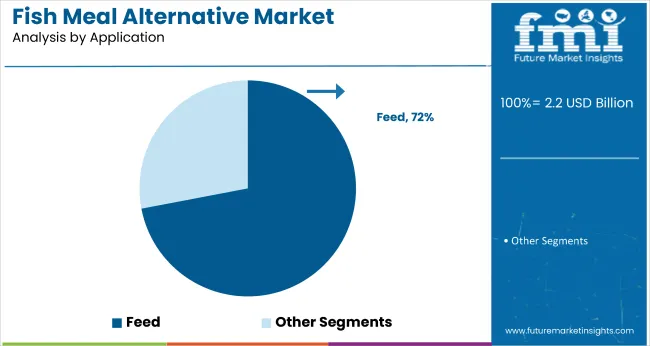
The feed application segment is expected to dominate the fish meal alternative market, holding a substantial 72% market share. This segment includes poultry, livestock, pet food, and treats, with aquaculture and poultry feed accounting for the largest consumption volumes.
The market is expanding steadily, driven by the push for sustainable aquaculture, growing environmental concerns over overfishing, and rising demand for plant-based and novel protein sources across feed applications.
Recent Trends in the Fish Meal Alternative Market
Key Challenges in the Fish Meal Alternative Market
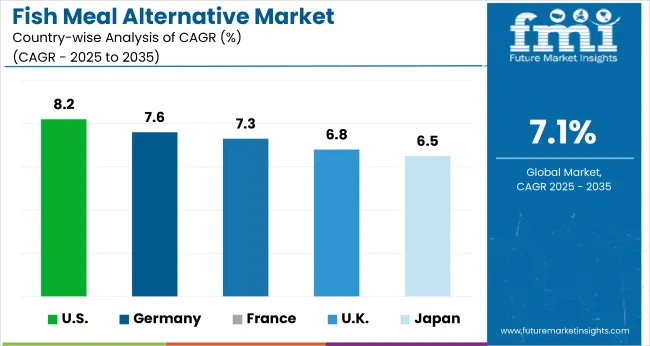
Among the top five countries in the market, the USA is projected to record the highest CAGR of 8.2% from 2025 to 2035, driven by federal support and innovation in sustainable feed. Germany follows with 7.6%, supported by its leadership in low-carbon animal farming. France is expected to grow at 7.3%, backed by strong sustainability regulations. The UK will expand at 6.8%, owing to ethical sourcing demands and regulatory pressure. Japan is set to grow at 6.5%, leveraging microbial and algae-based feed innovation aligned with its precision aquaculture practices.
The report covers an in-depth analysis of 40+ countries; five top-performing OECD countries are highlighted below.
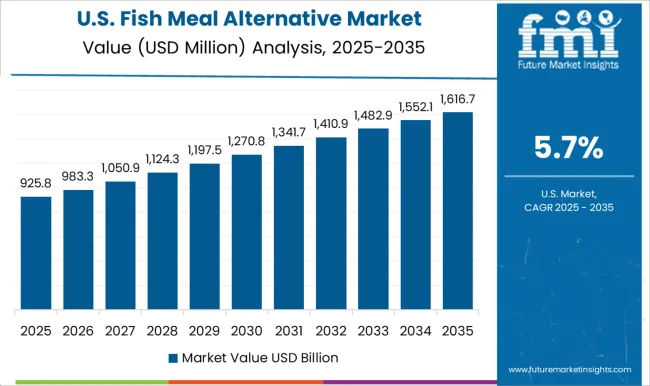
The USA fish meal alternative market is expected to grow at a CAGR of 8.2% from 2025 to 2035. Growth is being driven by increasing sustainability efforts in aquaculture and livestock farming, along with advancements in alternative protein research.
Sales of fish meal alternatives in the UKare projected to expand at a CAGR of 6.8% between 2025 and 2035. The UK is witnessing rising adoption of fish meal alternatives due to pressure from regulatory bodies and consumer demand for ethically produced seafood and meat.
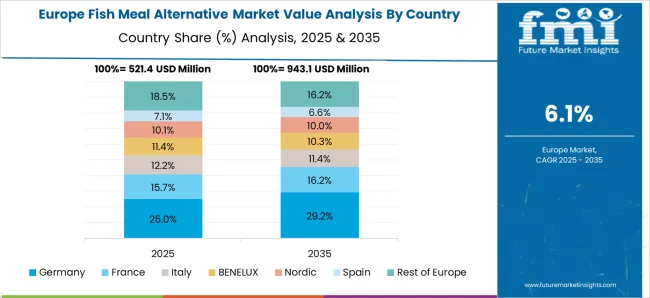
Fish meal alternatives revenuein Germany is expected to register a CAGR of 7.6%during 2025-2035. The country’s leadership in sustainable agriculture and animal feed innovation positions it as a key player in the fish meal alternative market
The French fish meal alternatives revenue is forecast to grow at a CAGR of 7.3% during the forecast period. Growing consumer awareness around sustainable farming practices and animal welfare is prompting feed manufacturers to adopt fish meal alternatives.

Japan fish meal alternative demand is projected to grow at a CAGR of 6.5% from 2025 to 2035.
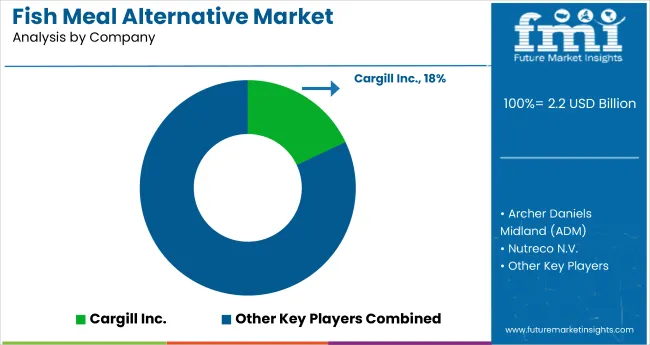
The global market is moderately fragmented, with a mix of global agribusiness giants and specialized biotech firms. Top-tier companies such as Cargill Inc., Archer Daniels Midland (ADM), Angel Yeast Co. Ltd, Nutreco N.V., and Alltech dominate the landscape, leveraging their vast distribution networks, R&D capabilities, and feed technology expertise to sustain competitive advantage.
Companies are competing primarily through product innovation, sustainable sourcing strategies, global expansion, and strategic partnerships. ADM and Cargill are actively expanding their alt-protein production footprints, while Angel Yeast and Calysta focus on microbial fermentation technologies to produce scalable protein-rich inputs
| Report Attributes | Details |
|---|---|
| Current Total Market Size (2025) | USD 2.2 billion |
| Projected Market Size (2035) | USD 4.4 billion |
| CAGR (2025 to 2035) | 7.1% |
| Base Year for Estimation | 2024 |
| Historical Period | 2020 to 2024 |
| Projections Period | 2025 to 2035 |
| Market Analysis Parameters | Revenue in USD billions/Volume in Metric Tons |
| By Type | Organic, Conventional |
| By Source | Plant (Peas, Lupins, Corn, Rice, Canola, Rapeseed, Barley, Wheat), Animal, Micro-organism |
| By Application | Feed (Poultry, Livestock, Pet Food, Treats), Fertilizers, Pharmaceuticals, Dietary |
| Regions Covered | North America, Latin America, Western Europe, Eastern Europe, East Asia, South Asia & Pacific, Middle East, and Africa |
| Countries Covered | United States, Canada, United Kingdom, Germany, France, Japan, South Korea, Brazil, Australia, +40 countries |
| Key Players | Al Dahra ACX, Archer Daniels Midland, Angel Yeast Co. Ltd, Cargill Inc., Calysta Inc., Lallemand Inc., Nutreco N.V., Alltech, Entofood, Midwest Ag Enterprises. |
| Additional Attributes | Dollar sales by value, market share analysis by region, and country-wise analysis. |
The global fish meal alternative market is estimated to be valued at USD 2.2 billion in 2025.
The market size for the fish meal alternative market is projected to reach USD 4.2 billion by 2035.
The fish meal alternative market is expected to grow at a 6.7% CAGR between 2025 and 2035.
The key product types in fish meal alternative market are conventional and organic.
In terms of source, plant segment to command 58.0% share in the fish meal alternative market in 2025.






Our Research Products

The "Full Research Suite" delivers actionable market intel, deep dives on markets or technologies, so clients act faster, cut risk, and unlock growth.

The Leaderboard benchmarks and ranks top vendors, classifying them as Established Leaders, Leading Challengers, or Disruptors & Challengers.

Locates where complements amplify value and substitutes erode it, forecasting net impact by horizon

We deliver granular, decision-grade intel: market sizing, 5-year forecasts, pricing, adoption, usage, revenue, and operational KPIs—plus competitor tracking, regulation, and value chains—across 60 countries broadly.

Spot the shifts before they hit your P&L. We track inflection points, adoption curves, pricing moves, and ecosystem plays to show where demand is heading, why it is changing, and what to do next across high-growth markets and disruptive tech

Real-time reads of user behavior. We track shifting priorities, perceptions of today’s and next-gen services, and provider experience, then pace how fast tech moves from trial to adoption, blending buyer, consumer, and channel inputs with social signals (#WhySwitch, #UX).

Partner with our analyst team to build a custom report designed around your business priorities. From analysing market trends to assessing competitors or crafting bespoke datasets, we tailor insights to your needs.
Supplier Intelligence
Discovery & Profiling
Capacity & Footprint
Performance & Risk
Compliance & Governance
Commercial Readiness
Who Supplies Whom
Scorecards & Shortlists
Playbooks & Docs
Category Intelligence
Definition & Scope
Demand & Use Cases
Cost Drivers
Market Structure
Supply Chain Map
Trade & Policy
Operating Norms
Deliverables
Buyer Intelligence
Account Basics
Spend & Scope
Procurement Model
Vendor Requirements
Terms & Policies
Entry Strategy
Pain Points & Triggers
Outputs
Pricing Analysis
Benchmarks
Trends
Should-Cost
Indexation
Landed Cost
Commercial Terms
Deliverables
Brand Analysis
Positioning & Value Prop
Share & Presence
Customer Evidence
Go-to-Market
Digital & Reputation
Compliance & Trust
KPIs & Gaps
Outputs
Full Research Suite comprises of:
Market outlook & trends analysis
Interviews & case studies
Strategic recommendations
Vendor profiles & capabilities analysis
5-year forecasts
8 regions and 60+ country-level data splits
Market segment data splits
12 months of continuous data updates
DELIVERED AS:
PDF EXCEL ONLINE
Fish Pond Circulating Water Pump Filter Market Size and Share Forecast Outlook 2025 to 2035
Fish Hydrolysate Market Size and Share Forecast Outlook 2025 to 2035
Fish Protein Isolates Market Size and Share Forecast Outlook 2025 to 2035
Fish Protein Concentrate Market Size and Share Forecast Outlook 2025 to 2035
Fish Feed Pellet Making Machine Market Size and Share Forecast Outlook 2025 to 2035
Fish Fermentation Market Size and Share Forecast Outlook 2025 to 2035
Fishing Reels Market Analysis - Size, Share, and Forecast Outlook 2025 to 2035
Fish Filleting Machine Market Size and Share Forecast Outlook 2025 to 2035
Fish Deboning Machine Market Size and Share Forecast Outlook 2025 to 2035
Fish Cutting Machine Market Size and Share Forecast Outlook 2025 to 2035
Fish Processing Equipment Market Size and Share Forecast Outlook 2025 to 2035
Fish Protein Hydrolysate Market Size and Share Forecast Outlook 2025 to 2035
Fish Protein Hydrolysate For Animal Feed And Pet Food Applications Market Size and Share Forecast Outlook 2025 to 2035
Fish Feed Ingredients Market Analysis - Size, Share, and Forecast Outlook 2025 to 2035
Fish Collagen Market Analysis - Size, Share, and Forecast Outlook 2025 to 2035
Fish Bone Minerals Market Analysis - Size, Share, and Forecast Outlook 2025 to 2035
Fish Peptones Market Size, Growth, and Forecast for 2025 to 2035
Fish Nutrition Market Size, Growth, and Forecast for 2025 to 2035
Fish Oil Market Analysis - Size, Share, and Forecast Outlook 2025 to 2035
Fish Sauce Market Growth - Culinary Trends & Industry Demand 2025 to 2035

Thank you!
You will receive an email from our Business Development Manager. Please be sure to check your SPAM/JUNK folder too.
Chat With
MaRIA